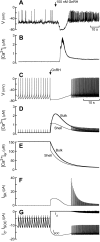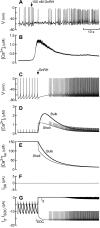Modeling of membrane excitability in gonadotropin-releasing hormone-secreting hypothalamic neurons regulated by Ca2+-mobilizing and adenylyl cyclase-coupled receptors
- PMID: 11125008
- PMCID: PMC6773020
- DOI: 10.1523/JNEUROSCI.20-24-09290.2000
Modeling of membrane excitability in gonadotropin-releasing hormone-secreting hypothalamic neurons regulated by Ca2+-mobilizing and adenylyl cyclase-coupled receptors
Abstract
Gonadotropin-releasing hormone (GnRH) secretion from native and immortalized hypothalamic neurons is regulated by endogenous Ca(2+)-mobilizing and adenylyl cyclase (AC)-coupled receptors. Activation of both receptor types leads to an increase in action potential firing frequency and a rise in the intracellular Ca(2+) concentration ([Ca(2+)](i)) and neuropeptide secretion. The stimulatory action of Ca(2+)-mobilizing agonists on voltage-gated Ca(2+) influx is determined by depletion of the intracellular Ca(2+) pool, whereas AC agonist-stimulated Ca(2+) influx occurs independently of stored Ca(2+) and is controlled by cAMP, possibly through cyclic nucleotide-gated channels. Here, experimental records from immortalized GnRH-secreting neurons are simulated with a mathematical model to determine the requirements for generating complex membrane potential (V(m)) and [Ca(2+)](i) responses to Ca(2+)-mobilizing and AC agonists. Included in the model are three pacemaker currents: a store-operated Ca(2+) current (I(SOC)), an SK-type Ca(2+)-activated K(+) current (I(SK)), and an inward current that is modulated by cAMP and [Ca(2+)](i) (I(d)). Spontaneous electrical activity and Ca(2+) signaling in the model are predominantly controlled by I(d), which is activated by cAMP and inhibited by high [Ca(2+)](i). Depletion of the intracellular Ca(2+) pool mimics the receptor-induced activation of I(SOC) and I(SK), leading to an increase in the firing frequency and Ca(2+) influx after a transient cessation of electrical activity. However, increasing the activity of I(d) simulates the experimental response to forskolin-induced activation of AC. Analysis of the behaviors of I(SOC), I(d), and I(SK) in the model reveals the complexity in the interplay of these currents that is necessary to fully account for the experimental results.
Figures






Similar articles
-
Autocrine regulation of calcium influx and gonadotropin-releasing hormone secretion in hypothalamic neurons.Biochem Cell Biol. 2000;78(3):359-70. Biochem Cell Biol. 2000. PMID: 10949086 Review.
-
Control of action potential-driven calcium influx in GT1 neurons by the activation status of sodium and calcium channels.Mol Endocrinol. 1999 Apr;13(4):587-603. doi: 10.1210/mend.13.4.0261. Mol Endocrinol. 1999. PMID: 10194765
-
cAMP modulates the excitability of immortalized H=hypothalamic (GT1) neurons via a cyclic nucleotide gated channel.Mol Endocrinol. 2001 Jun;15(6):997-1009. doi: 10.1210/mend.15.6.0653. Mol Endocrinol. 2001. PMID: 11376117
-
Regulation of Ca2+-sensitive adenylyl cyclase in gonadotropin-releasing hormone neurons.Mol Endocrinol. 2001 Mar;15(3):429-40. doi: 10.1210/mend.15.3.0610. Mol Endocrinol. 2001. PMID: 11222744
-
Regulation of gonadotropin-releasing hormone release by cyclic AMP signalling pathways.Growth Horm IGF Res. 2001 Jun;11 Suppl A:S9-15. doi: 10.1016/s1096-6374(01)80003-4. Growth Horm IGF Res. 2001. PMID: 11527095 Review.
Cited by
-
Pulsatile GnRH secretion: roles of G protein-coupled receptors, second messengers and ion channels.Mol Cell Endocrinol. 2010 Jan 27;314(2):158-63. doi: 10.1016/j.mce.2009.05.015. Epub 2009 May 30. Mol Cell Endocrinol. 2010. PMID: 19486924 Free PMC article. Review.
-
Gonadotropin-releasing hormone-1 neuronal activity is independent of hyperpolarization-activated cyclic nucleotide-modulated channels but is sensitive to protein kinase a-dependent phosphorylation.Endocrinology. 2008 Jul;149(7):3500-11. doi: 10.1210/en.2007-1508. Epub 2008 Mar 27. Endocrinology. 2008. PMID: 18372334 Free PMC article.
-
Synaptic integration in hypothalamic gonadotropin releasing hormone (GnRH) neurons.Neuroscience. 2008 Jul 17;154(4):1337-51. doi: 10.1016/j.neuroscience.2008.04.067. Epub 2008 May 9. Neuroscience. 2008. PMID: 18556136 Free PMC article.
-
A simple integrative electrophysiological model of bursting GnRH neurons.J Comput Neurosci. 2012 Feb;32(1):119-36. doi: 10.1007/s10827-011-0343-y. Epub 2011 Jun 11. J Comput Neurosci. 2012. PMID: 21667154
-
Modelling KNDy neurons and gonadotropin-releasing hormone pulse generation.Curr Opin Endocr Metab Res. 2022 Dec;27:100407. doi: 10.1016/j.coemr.2022.100407. Curr Opin Endocr Metab Res. 2022. PMID: 36632147 Free PMC article. Review.
References
-
- Berridge MJ. Neuronal calcium signaling. Neuron. 1998;21:13–26. - PubMed
-
- Boulay G, Brown DM, Qin N, Jiang M, Dietrich A, Zhu MX, Chen Z, Birnbaumer M, Mikoshiba K, Birnbaumer L. Modulation of Ca2+ entry by polypeptides of the inositol 1,4,5-trisphosphate receptor (IP3R) that bind transient receptor potential (TRP): evidence for roles of TRP and IP3R in store depletion-activated Ca2+ entry. Proc Natl Acad Sci USA. 1999;96:14955–14960. - PMC - PubMed
MeSH terms
Substances
LinkOut - more resources
Full Text Sources
Miscellaneous
